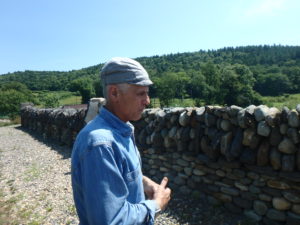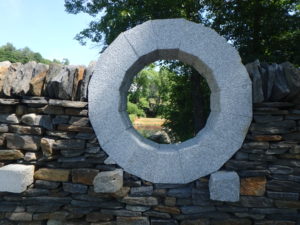Tips for Building a Stone Retaining Wall
Many years ago, when I was young and foolish, I decided to build an 80-foot long terrace for fruit trees, and to edge it with a nice fieldstone retaining wall using stones I could find on my property or on the nearby property of a friend. It was a lot of work, a lot of fun, and I made a lot of mistakes. That wall still stands 30 years later, but I’ve had to fix it many times.
If you want to build a retaining wall, do your homework! Read up on the process before you start. This article will give you a few basics, but taking a workshop, or working with an expert waller, or reading a book or two will help a lot.
I recently went to Dummerston, Vermont to talk to master dry stone waller Dan Snow. He is one of the founding members of The Stone Trust on the Scott Farm in Dummerston. Here are a few of his suggestions.
Building a wall that withstands the test of time, it is important to start the wall on a good base that drains well. He recommends digging out a trench and filling it with half- to three quarter-inch diameter crushed stone. This is not gravel, which contains “fines”, meaning sand and clay particles, which is not what you want.
The taller the wall, the deeper the base of crushed stone should be. The general rule he suggested is that the depth of crushed stone should be one half the height of the wall. Building a 3-foot retaining wall? An 18-inch ditch filled with crushed stone is a good start.
The exception to the rule of starting with a footing of crushed stone is if you are placing the wall on a heavy clay base. Clay can insinuate itself into the spaces between stones, and clogging the drainage. Sand, however, won’t do that, and can be used as the base. If the wall sits on a base that floods in spring, you may have to install drains to carry away the water.
Dan Snow suggested the 1-2-3 rule for retaining walls. These numbers refer to the proportions of the wall: top width to bottom width to height. A 3-foot tall wall should be roughly 2 feet wide at the base, and one foot wide at the top.
When building any wall, free standing or retaining, it is important to have each course of stone level. And a gentle slope or pitch to the outside of the wall is needed, too. Many wallers use strings and a wooden framework to establish the batter, or pitch of the wall. In general, for every 12 inches of wall height, 2 inches of tip backwards is good.
Another basic principle of building walls, as explained on the website of The Stone Trust (www.thestonetrust.org) is to turn long stones into the wall instead of placing them along the length of the wall. That was a mistake I made many times when building my retaining wall. A nice 30-inch stone placed lengthwise along with wall gives you a nice look, but it is not holding the wall in place the way it would if inserted from front to back in the wall.
Dan Snow also reminded me of the old saying, “Two stones over one, one stone over two.” Which means, never stack similar sized stones over each other. You want each stone to be in contact with more than one stone above and below.
I asked Dan about using landscape fabric behind a retaining wall. I thought that this was a good practice, as it can keep soil from washing into the wall, filling spaces and clogging drainage. If a wall holds water behind it, and it freezes, he explained, the frost can push a wall forward. But Dan is not big on landscape fabric; he would rather just establish very good drainage so that it is not an issue.
Many gardeners who have a hilly site want stone steps to facilitate going up or down hills without slipping on wet grass. We looked at steps at The Stone Trust, and Dan explained the basics: Start at the bottom, and build upwards. Be sure that each subsequent stone sits on the back of the stone below it. The weight of the upper stone will hold the lower stone in place. Finally, be sure that the front of each riser is either vertical, or hangs over any stones supporting it. He said that it is important, when you step down, that your heel not hit a piece of stone that is forward of the lip of the step.
For the past 9 years The Stone Trust has offered classes and multi-day workshops for home gardeners and dry stone wallers to learn the skills needed to work with stone. I wish I had taken a workshop before I ever tried building a wall.
Dan Snow has two excellent books on stone work: Listening to Stone: Hardy Structures, Perilous Follies and Other Tangles with Nature, and In the Company of Stone: The Art of the Stone Wall. Much of what he builds is art or whimsy, and the photos by Peter Mauss are remarkable. Dan’s web site is https://www.
Another excellent resource for working with stone is by Gordon Hayward, who is a neighbor and friend of Dan’s, an excellent garden designer, and the author of many fabulous books. His book Stone in the Garden: Inspiring Designs and Practical Projects is full of great photos and very specific, useful advice. I highly recommend it.
Don’t be daunted by stone. Learn to use it well and it will please you every time you go to your garden – even if your walls are not perfect.
You may reach Henry at henry.homeyer@comcast.net or P.O. Box 364, Cornish Flat, NH 03746. He is the author of 4 gardening books, and loves good stone work.





